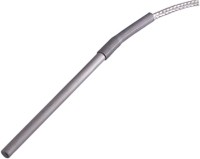
Resistance thermometers of platinum (Pt)
Main Features
The PT100 thermo-resistance (commonly called “PT100”) are suitable for temperature-sensitive elements to measure the temperature given their particular sensitivity, precision and reliability.
Available in any shape, size and material, the PT100 are commonly applied in all those application fields where the maximum working temperature is ≤650°C (1200°F).
ADVANTAGES:
Typical applications
PT100 probes are widely used in the following areas of use:
Technical Data
A standard type PT100 thermal resistance for a cylindrical sheath with 304, suitable for measuring temperatures and general adjustments. This model presents the output from the sheath of the cable protected by a stainless steel spring, which can be housed within one or two sensing elements which can be connected to 2, 3 or 4-wire (only with a sensing element ).
| Operating temperature | Varies according to the model depending on the type of cable |
| Accuracy / measurement accuracy | in accordance with regulationsEN60751 classe A,B o AA |
| Type of execution | standard |
| Type model (temperature scale) / Type of cable | 0/400°C, -40/+200°C, -50/+240°C, -20/+105°C |
| Number of sensitive elements | Single or Double |
| Sensor type | PT 100, PT1000, Ni 100, PTC 1 kOhm 25°C, NTC 10 Kohm 25°C |
| Connection Type | a 2-wires, a 3-wires oppure a 4-wires |
| Sheath Diameter (OG) | Ø 4 – 6 – 8 mm or other customer-specific |
| Sheath Material | AISI304, AISI316 |
| Immersion length (LG) | 30, 50, 100, 200 or other customer-specific |
| Extension Length (if present) (LC) | to be specified in dm |
| Threaded connection (if any) | G. 1/8″, 1/4″, 3/8″, 1/2″ |
Also suitable for use in diving, the PT100 can also be supplied complete with connection head, suitable for measurement and control of generic systems. Their attachment is via a threaded sleeve welded directly on the (fixed) or by special joints or flange sliding compression. The electrical connection is made within the connection head through a ceramic terminal block. On request they can be alternatively provided with an analog output 4-20 mA.
| Operating temperature | Variable depending on model |
| Accuracy / measurement accuracy | in accordance with regulations EN60751 classe A,B o AA |
| Type of protection (protection) | minimum IP54 |
| Electrical connections | M20x1,5 |
| Number of sensitive elements | Single or Double |
| Sensor type | PT 100, PT 1000, PT 100, or 4-20mA analog output |
| Type model (temperature scale) | -80+600°C, -200+850°C, -80+250°C or drilled-40+500°C |
| Connection Type | 2-wire, 3-wire, 4-wire (only with simple sensing element) |
| Sheath Diameter (OG) | Ø 6 – 8 – 10 – 12 mm |
| Sheath Material | AISI304, AISI316 |
| Immersion length (LG) | 50, 100, 200 or other customer-specific |
| Connection head (if present) | IP45, IP54, IP65 or aluminum IP65 ATEX Eexd IIC T6 |
| Extension Length (if present) (LC) | 50, 100, 150 mm |
| Threaded connection (if any) | G. 1/8″, 1/4″, 3/8″, 1/2″ |
The technical parameters necessary for the design and identification of the PT100 model best suits the needs of the customer are:
QUALITY CONTROL
All our PT100 are thoroughly subjected to the most stringent tests of quality and safety, by means of automatic machines and in full compliance with applicable regulations and international standards.
Made according to international standards EN60751, under which it is used with platinum temperature coefficient alpha = 3.851 E-03,
platinum resistance thermometers (RTD Platinum) can alternatively be built to customer specifications in accordance with other standards such as, for example, JIS C 1604, etc. …
The EN 60751 provides resistance thermometers with a nominal value at 0 ° C (Ro) between 5 and 1000 ohms, but the values most commonly used are 100 ohms, 500 ohms and 1000 ohms.
The relationship between the resistance at temperature t ° (Rt) and the resistance at 0 ° (Ro) is as follows:
| in-200°C / 0°C | –> Rt = Ro [ 1+At+Bt²+C ( t-100 ) t³ ] |
| in 0°C / 850°C | –> Rt = Ro ( 1+At+Bt² ) |
where: A = 3,9083E-03 / B = -5,775E-07 / C = -4,183E-12
The accuracy classes of platinum resistance thermometers are related to temperature and are normalized so:
| Class AA | = 0,1+0,0017* | t | ( °C ) |
| Class A | = 0,15+0,002* | t | ( °C ) |
| Class B | = 0,3+0,005 | t | ( °C ) |
| Class C | = 0,6+0,01 | t | ( °C ) |
The temperature ranges of validity of the tolerance classes above are listed in the table below.
All resistance thermometers with higher tolerance to class B should have a three-or four-wire.
SOME EXAMPLES: